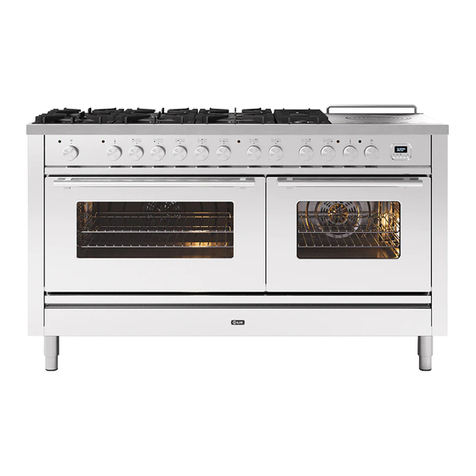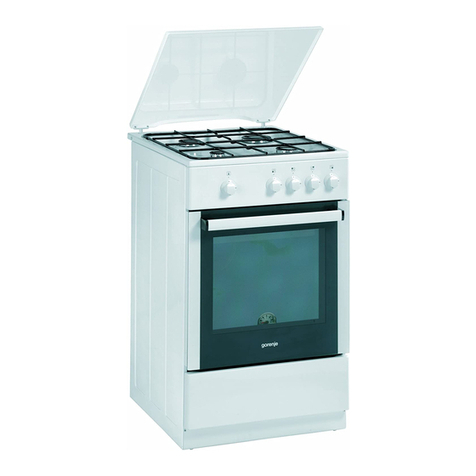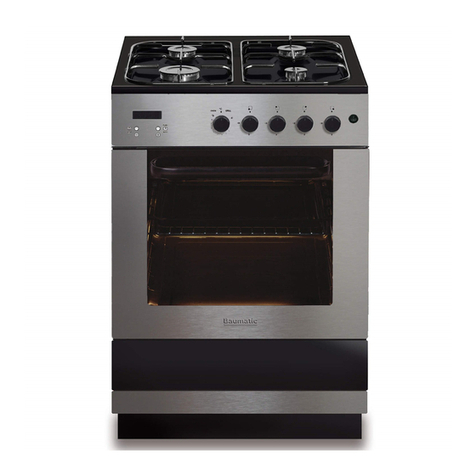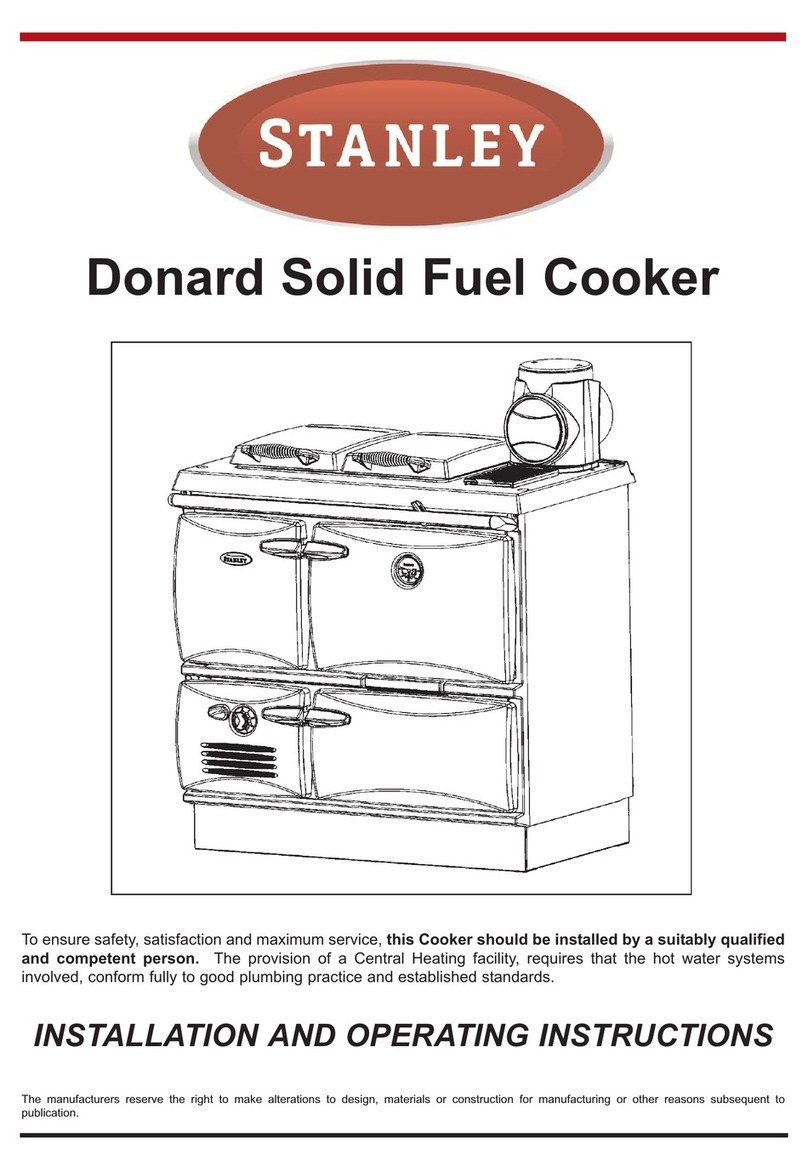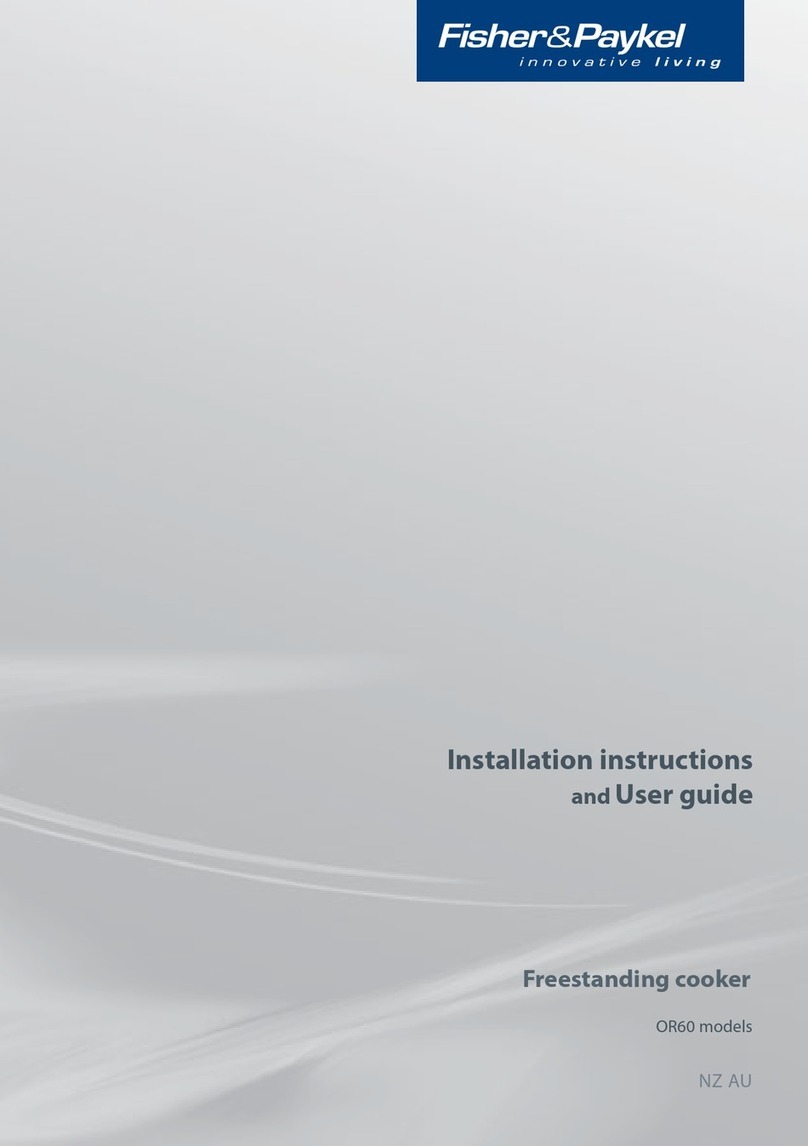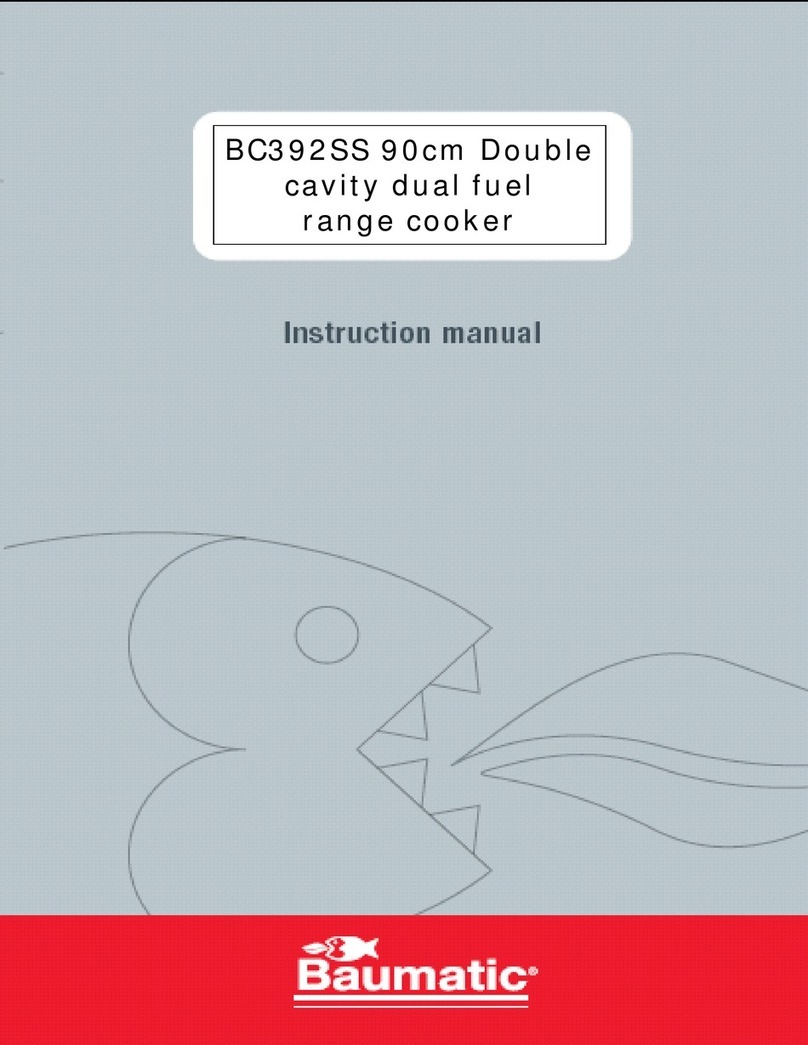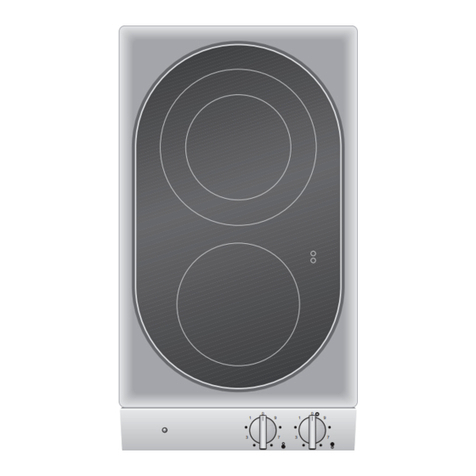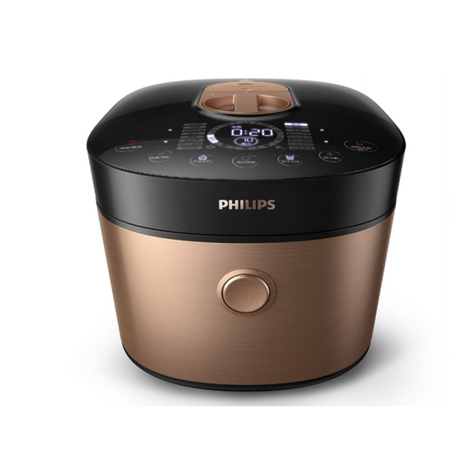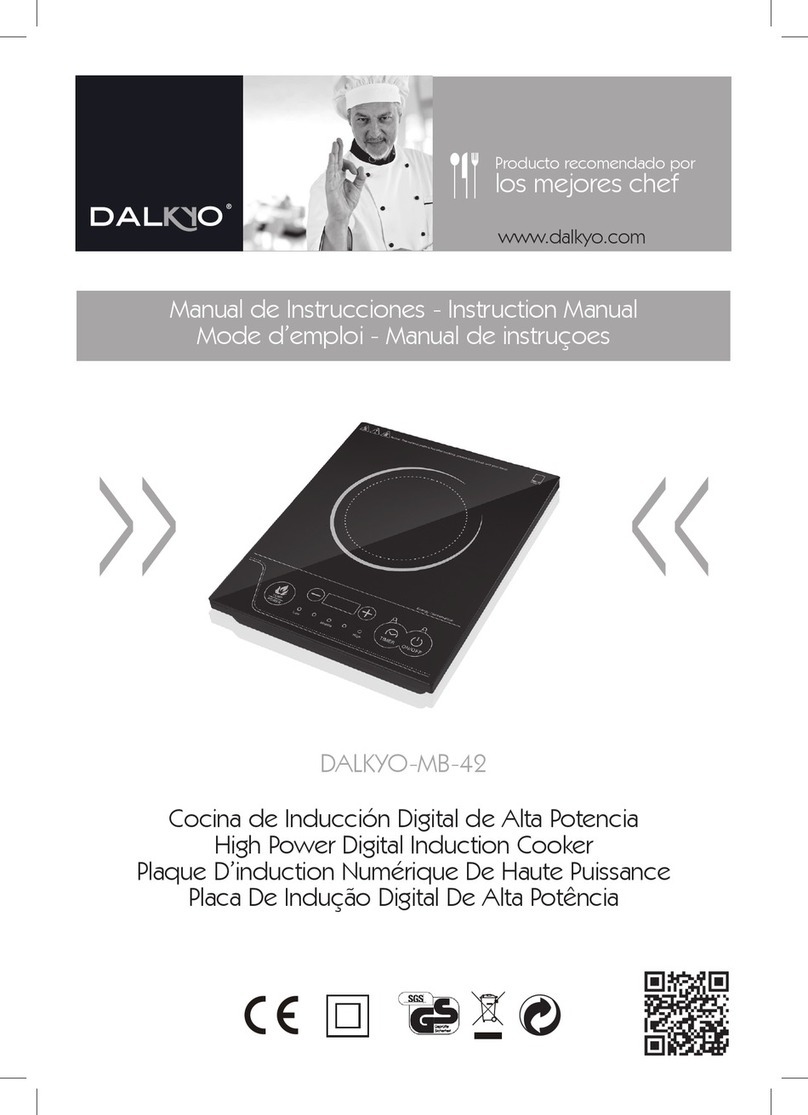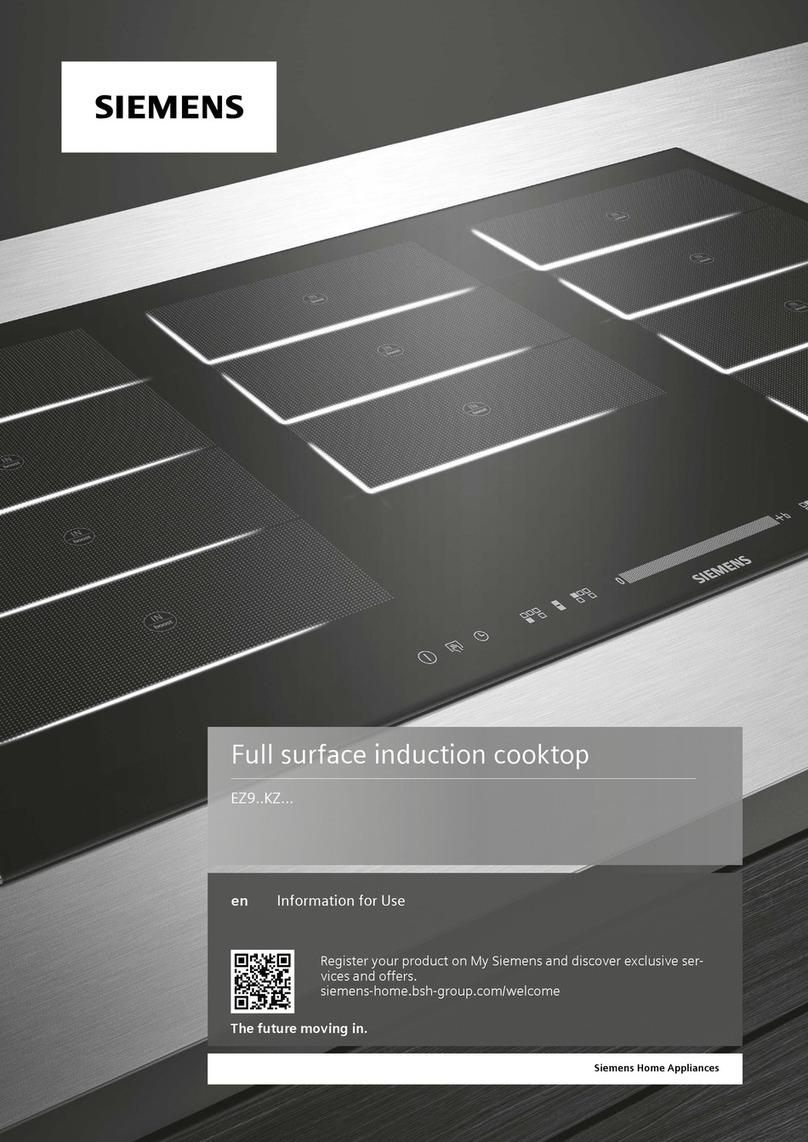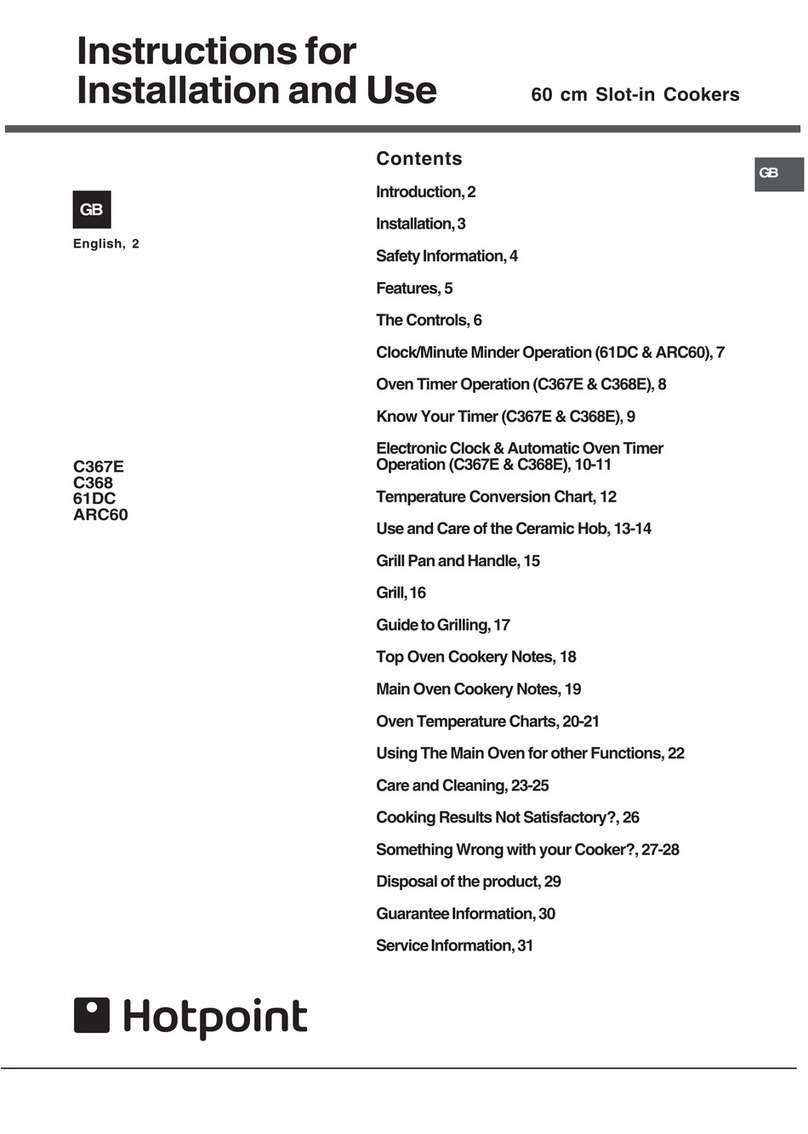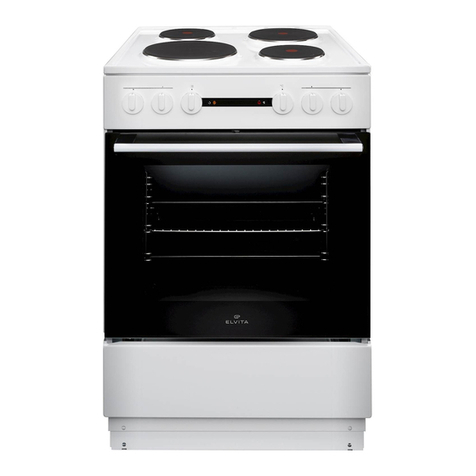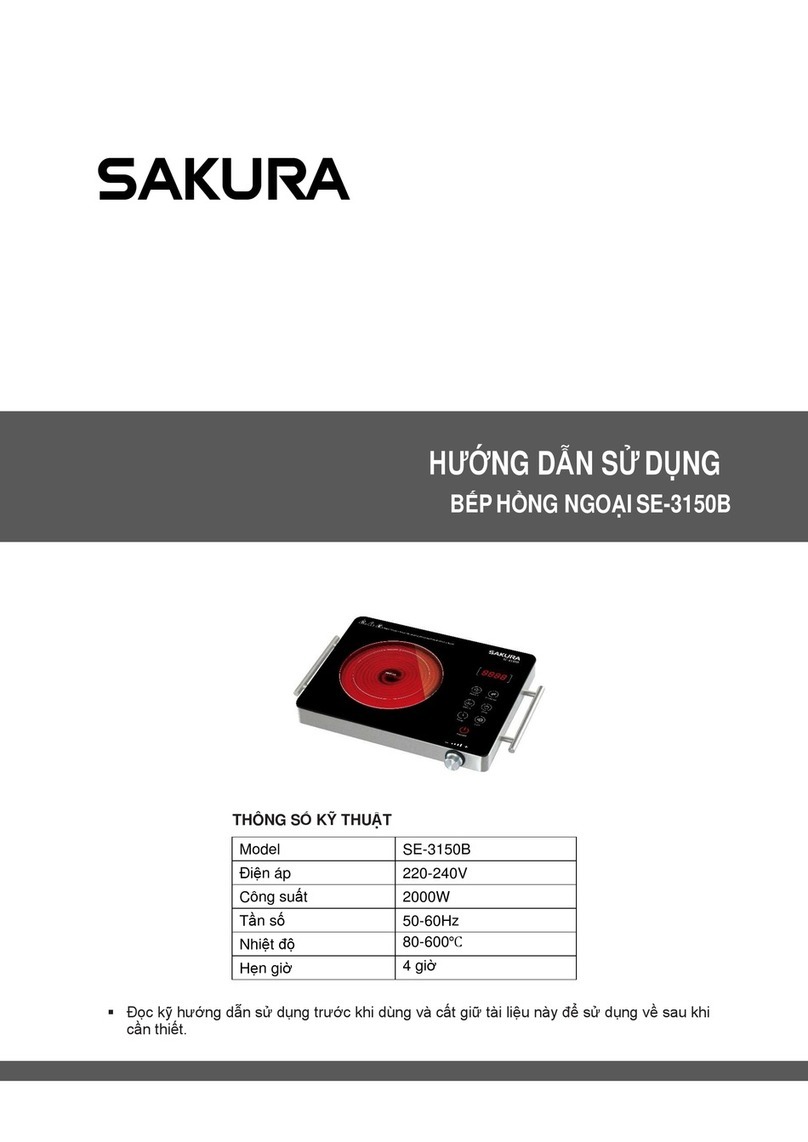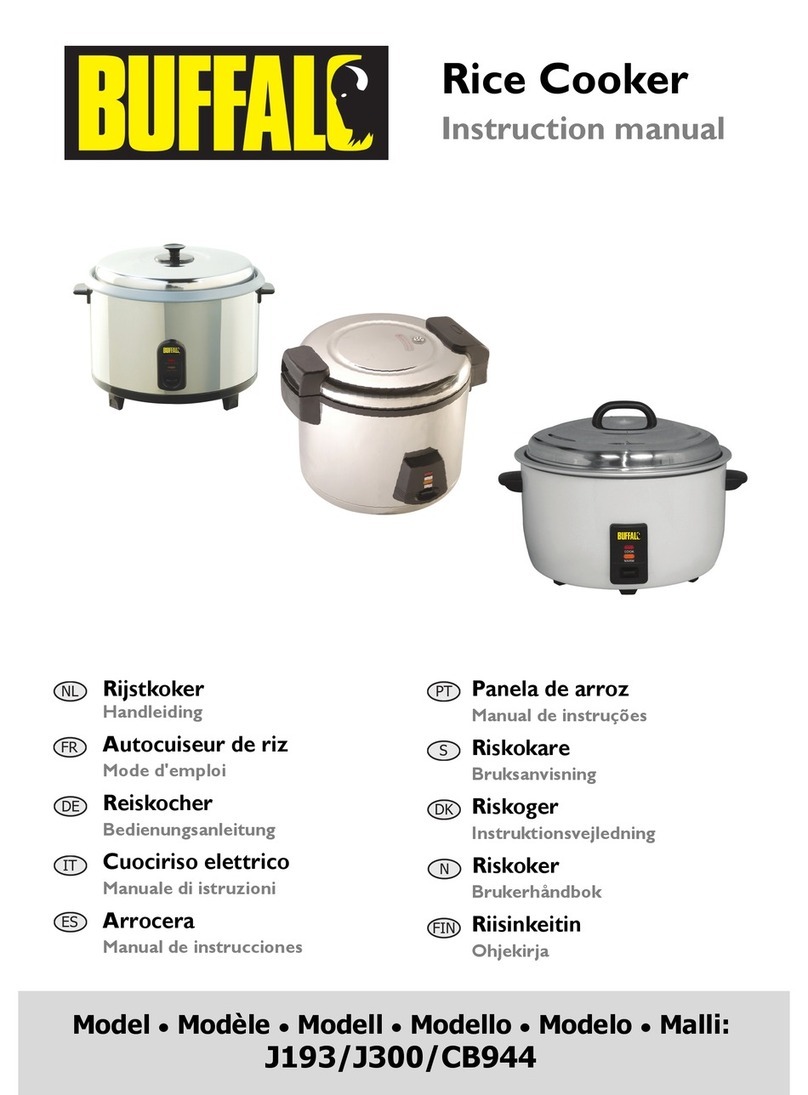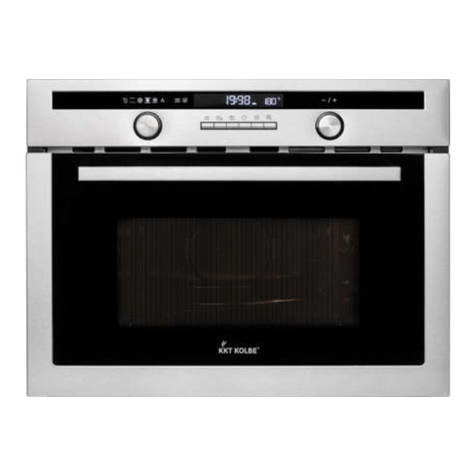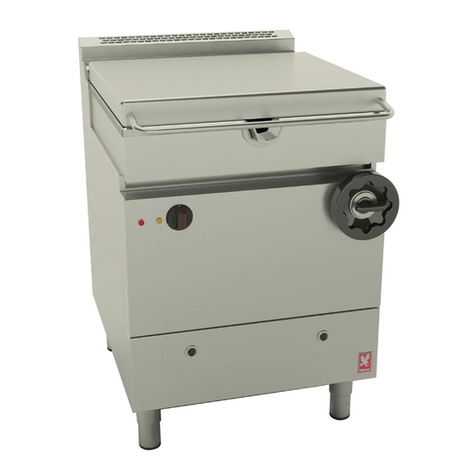General Gas CR6060 Installation and operating instructions

INSTRUCTIONS AND ADVICE
FOR INSTALLING, USING AND SERVICING
OF COOKERS

2
461307346 (RS-001)
The appliance was designed and made in accordance with the European standards listed below:
=> EN 30-1-1, EN 30-2-1 and EN 437 plus subsequent amendments (gas)
=> EN 60 335-1 and EN 60 335-2-6 (electrical) plus relative amendments
The appliance complies with the prescriptions of the European Directives as below:
=> 2006/95 EC concerning electrical safety (BT).
=> 89/336 + 92/31 + 93/68 EC concerning electromagnetic compatibility (EMC)
=> 90/396 + 93/68 EC concerning gas safety.
---------------------------------------------------------------------------------------------------------------------------------------------------
Oven accessories that could come into contact with foodstuffs are made with materials that comply with
the provisions of the 89/109 EC directive dated 21/12/88.
---------------------------------------------------------------------------------------------------------------------------------------------------
This product complies with EU Directive 2002/96/EC.
The crossed-out dustbin symbol reported on the appliance indicates that the appliance must be disposed
of separately from other domestic refuse at the end of its useful life. It must therefore be delivered to a
waste recycling centre specifically for electric and electronic equipment or returned to the retailer at the
moment of purchase of a new equivalent appliance.
The user is responsible for delivering the appliance to the appropriate collection centre at the end of its
useful life, Failure to do so may result in a fine, as provided for by laws governing waste disposal.
Differential collection of waste products for eventual recycling, treatment and environmentally friendly
disposal helps reduce possible negative effects on the environment and health, and also enables the
materials making up the product to be recycled.
For more detailed information on the available refuse collection systems, refer to the local Municipal
Solid Waste disposal centre or the shop where the product was purchased.
Producers and importers are responsible for fulfilling their obligations as regards recycling, treatment
and environmentally friendly disposal by directly or indirectly participating in the collection system.
CONTENTS
1. IMPORTANT NOTES AND PRECAUTIONS FOR USE 3
2. DESCRIPTION OF THE APPLIANCE 4-6
3. INSTRUCTIONS FOR THE USER 7-15
4. TROUBLESHOOTING 16
5. TECHNICAL FEATURES 16-17
6. INSTRUCTIONS FOR THE INSTALLER 18-25
7. ASSISTANCE AND SPARE PART 26

3
461307346 (RS-001)
You have purchased one of our products for which we
thank you. We are confident that this new appliance,
modern, functional and practical, made with top quality
materials, will meet all your demands. This new appliance
is easy to use but before installing and using it, it is
important to read this handbook through carefully.
It provides information for a safe installation, use and
maintenance. Keep this handbook in a safe place for
future reference.
The manufacturer reserves the right to make all the
modifications to its products that it deems necessary
or useful, also in your interests, without prejudicing
its essential functional and safety characteristics.
The manufacturer cannot be held responsible for any
inaccuracies due to printing or transcription errors that
may be found in this handbook.
N.B.: the pictures shown in the figures in this handbook
are purely indicative.
• The installation, adjustments, conversions and
maintenance operations listed in section «6.
INSTRUCTIONS FOR THE INSTALLER” must only
be carried out by qualified personnel .
Warning: Under the Gas Safety (Registration of
Gas Installers and Gas Contractors) Regulations,
only registered gas installers (registered to
appropriate class) employed by registered
gas contractors can personally carry out gas
installation work “Gas Installation Work” includes
the fabrication, connection, or replacement of gas
pipework, appliances and fitting.
• The installation of all-gas and combi appliances must
comply with the standards in force.
• The appliance must only be used for its original
purpose, that is, cooking for domestic use. Any other
use is considered improper and, as such, dangerous.
• The manufacturer cannot be held responsible for
any damage to persons or property resulting from
an incorrect installation, maintenance or use of the
appliance.
• Once the packaging has been removed from the
outer surfaces and the various inner parts, thoroughly
check that the appliance is in perfect condition. If you
have any doubts do not use the appliance and call in
a qualified person.
• The packaging materials used (cardboard, plastic
bags, polystyrene foam, nails, etc.) must not be left
with in easy reach of children because they are a
potential hazard source. All packaging materials used
are environmentally-friendly and recyclable.
• Theelectricalsafetyofthisapplianceisonlyguaranteed
if it is correctly connected to a suitable earth system,
as prescribed by the electrical safety standards.
The manufacturer disclaims all responsibility if these
instructions are not followed. Should you have any
doubts, seek the assistance of a qualified person.
• Before connecting the appliance ensure that the
rating plate data corresponds to that of the gas and
electricity supply (see section «5 - TECHNICAL
FEATURES»).
The use of any electrical appliance requires certain
fundamental rules to be observed:
# Do not touch the appliance with wet or damp hands or
feet.
# Do not use the appliance when barefoot.
# Do not pull the power cable to unplug the appliance
from the mains socket.
# Do not leave the appliance exposed to the atmosphere
(rain, sun, etc.).
# Do not allow the appliance to be used by unsupervised
children or inexperienced persons.
• Before using the oven for the first time, heat
and maintain at the maximum temperature for
approximately two hours, while empty and with the
door closed. This will expel the characteristic odour
produced by the rock wool insulating material.
Ventilate the room during this operation.
• During and after use, the glass of the oven door and
the accessible parts may be very hot. Therefore, keep
children away from the appliance.
• Keep the appliance clean. Food residues can be a fire
hazard.
• When the oven is not in use, do not use it to store
foodstuffs or containers: if it is accidentally turned on,
it can cause damage and accidents.
• If an electrical socket near the appliance is used,
ensure that the cables of any other electrical
appliances do not come into contact with the oven
and are at a sufficient distance from the hot parts of
the oven.
• After using the appliance ensure that all the controls
are in the off or closed position, and check that the “0”
on the knob corresponds with the symbol “•“ printed
on the front panel.
• Before carrying out any kind of cleaning, adjustment,
conversion or maintenance operation, disconnect the
appliance from the electricity supplies.
• In case of problems and/or malfunction, turn off the
appliance and disconnect it from the mains electricity
supplies, Do not attempt to tamper with it. Any repairs,
or adjustments must be carried out exclusively by
qualified personnel. For this reason, we recommend
that you to contact your nearest Service Centre
specifying the model of your appliance and the type
of problem.
1. IMPORTANT NOTES AND PRECAUTIONS FOR USE

4
461307346 (RS-001)
4
3
2
1
1
B
A
2
AB
2
1
2
3
4
5
6
1
PRESENTATION
Our cookers are fitted with a fully hob.
The burners can be equipped with safety thermocouples (Tc) (see fig. 10).
Each knob on the front panel has a diagram printed above it showing to which burner or hotplate it refers. The
combination of the different sized burners offers the possibility of various types of cooking.
Our cookers are fitted with all gas oven.
The oven walls are fitted with various runners (fig. 1) on which the following accessories can be placed. Supply
and quantities vary from model to model (fig. 2):
• oven shelf (A)
• enamelled drip tray or drip pan (B)
• spit support + spit + forks + knob (on page 10)
The cookers can be fitted with a warming drawer (not completely extractable) or with a small compartment, that
can be used for storing things.
Remember that the surfaces become hot, it is strictly forbidden to place inflammable materials inside.
2. DESCRIPTION OF THE APPLIANCE

5
461307346 (RS-001)
2. DESCRIPTION OF THE APPLIANCE
CONTROL PANELS
A. Gas burner knob
B. Gas oven/grill thermostat knob
C. Oven light switch
D. Spit roast switch
E. Timer knob
MODEL: CR6060..
MODEL: CR8050..
BAEC
D
C ABAEAD

6
461307346 (RS-001)
DESCRIPTION OF THE CONTROLS
HOB GAS BURNER KNOB (ref. A)
By rotating the knob in an anticlockwise direction, the
following symbols appear:
0= Closed position
= “Full on” position
= “Reduced rate” position
GAS OVEN/GRILL THERMOSTAT KNOB (ref. B)
By rotating the knob in an anticlockwise direction, the
following functions appear:
0= Closed position
from Min. to Maxi = Oven temperatures
Turn the knob clockwise if you want to use the gas
grill or .
OVEN LIGHT SWITCH (ref. C)
SPIT ROAST SWITCH (ref. D)
TIMER KNOB (ref. E)
To set cooking time, first wind the timer up by turning it
completely once from left to right and then back to the
number of minutes you want. The timer will ring when
the set time has elapsed.
2. DESCRIPTION OF THE APPLIANCE
A
055
50
45
40
35
30
25
20
15
10
5
E
Min
140
160
180
200
220
240
260
B
Min
155
180
205
255 230
Maxi
B

7
461307346 (RS-001)
HOB: GENERAL NOTES ON SAFETY
• When using the burners, do not leave the appliance
unsupervised. Ensure that children do not play with
the appliance. In particular, make sure that pan
handles are positioned correctly and supervise the
cooking of foods which use oils and fats, as these
are highly inflammable.
• Do not use aerosols or sprays near the appliance
when it is in use.
• If the appliance is fitted with a lid, remove any food
residues on the surface before opening.
• If the appliance is fitted with a crystal glass lid, this
can shatter when heated. Turn off all the burners
and to attend that is cooled, before closing the lid
(fig. 3).
• Even after use, the burners remain hot for a long
period; to avoid burning, do not place hands or
other objects on them.
• After using the appliance, ensure that all the controls
are in the closed position.
When a gas cooker is being used it produces
heat and humidity in the room where it is
installed. For this reason the room must be
well ventilated, keeping the natural ventilation
openings free (fig. 15) and switching on the
mechanical aeration system (suction hood or
electric fan, figs. 16 and 17).
If the cooker is used for a long time additional
aeration may be necessary, for instance,
opening a window, or a more effective aeration
by increasing the power of the mechanical
system if there is one.
3. INSTRUCTIONS FOR THE USER
LIGHTING THE BURNERS
a) Manual ignition
Press and turn counterclockwise the knob
corresponding to the burner you wish to use, until it
reaches to the «Full on» position and placing a
lighted match to the burner.
b) Automatic electric ignition of burners
(ref- AC - fig. 10)
Push lightly the knob corresponding to the burner you
wish to use and turn counterclockwise to the «Full
on» position , then depress the control knob.
Automatically the ignition spark shoots.
Matches can be used to light the burners in a
blackout.
c) Lighting of burners equipped with safety
thermocouples (ref. TC - fig. 10)
(only certain versions)
Inthecaseofburnersequippedwithsafetythermocouples
you have to turn counterclockwise to the «Full on»
position , the knob corresponding to the burner
you wish to use, then press the knob and repeat the
operations described previously. Once lit, keep the
knob pressed for about 10 seconds.
4
3

8
461307346 (RS-001)
2
1
A
1
2
A
5
5
d) Optimum use of the burners
In order to achieve maximum efficiency with minimum
gas consumption it is useful to remember:
• Do not use large burners with pans of small diameter
in order to avoid flames spreading wider than pans
(consult the following table) and always use pans
with lids (see fig. 4).
• Avoid using over sized pans that may radiate
excessive heat and cause damage to surrounding
surfaces such as bench tops and glass lid.
• The appliance is equipped with a particular pan
support (1) on which must be put the wok support
(2). To ensure stability, position the notch (A) of wok
support on the pan support fingers as indicated in
fig. 5.
• Do not place anything, e.g. flame tamer, asbestos
mat, between pan and pan support, as serious
damage to the appliance may result.
• Locate pan centrally over the burner so that is stable
and does not overhang the appliance.
• Do not use burners without the proper pan support
or wok stand, as this will concentrate and deflect the
heat onto the hotplate and surrounding surfaces.
• When the boiling point is reached, it is best to turn
the knob to the “Reduced rate position” (small
flame).
• If gas burns with a yellow flame, do not continue to
use burner and arrange for service.
• Do not use aluminium mat. Use of aluminium mat
may cause combustion problem.
Burners Ø pans - cm
Wok 22÷24
Rapid 20÷22
Semi-rapid 16÷18
Auxiliary 12÷14
3. INSTRUCTIONS FOR THE USER
OVEN: GENERAL SAFETY INSTRUCTIONS
• Do not leave the oven unsupervised during use.
Ensure that children do not play with the appliance.
• Always keep the appliance lid open when using the
oven, in order to prevent overheating.
• Always grip the centre of the oven door when
opening. Do not practice excessive pressures on
the door when it is open.
• Do not worry if condensation forms on the door and
on the internal walls of the oven during cooking.
This does not compromise its efficiency.
• When opening the oven door, be very careful of
scalding vapours.
• The appliance becomes very hot during use. Do not
touch the heating elements inside the oven. Wear
oven gloves when placing or removing pans from
the oven.
• When inserting or removing food from the oven,
check that excess juices do not overflow onto the
oven base (oils and fats are highly inflammable
when overheated).
• Use containers that will resist the temperatures
indicated on the thermostat knob.
• For good results during cooking, we strongly
recommend not to cover the base of the oven or the
grill with aluminium foil or other materials.
• When grilling, always use the drip pan to catch the
gravy and always put a little water in the grill pan. The
water prevents the grease from burning and from
giving off bad smells and smoke. Add more water
during grilling to compensate for evaporation.
• After using the appliance ensure that all the controls
are in the closed position.
• WARNING!!! During and after use, the oven door
glass and the accessible parts can be very hot,
therefore keep children away from the appliance.
IMPORTANT!!_Always keep the oven door closed
during baking. It must only be left open when using
the gas grill burner (see relative instructions).

9
461307346 (RS-001)
B
6
C
B
6
3. INSTRUCTIONS FOR THE USER
WHAT TO DO THE FIRST TIME YOU USE THE OVEN
Before cooking for the first time, ensure the oven is empty and its door closed, heat the oven at maximum tem-
perature for 2 hours. This will allow the protective coating on the interior of the oven to be burnt off and dissipate
the associated smells. During this time do not stay in the same room and keep it aerated.
After the hour or so has elapsed leave the oven to cool down and then clean its interior with hot water and a mild
detergent. Also wash the accessories (shelves, trays, drip pan, spit..) prior to use.
Prior to any cleaning, disconnect the appliance from the electricity mains.
HOW TO USE GAS OVEN AND GRILL
The oven and grill burner can be fitted with a safety thermocouple so, once the burner has been lit,
keep the knob pressed for about 15 seconds. If, at the end of this time, the burner fails to light, release
the knob and wait at least 1 minute before trying again. Should the burner turn out accidentally, turn
the knob round to the closed position and wait at least 1 minute before lighting it again.
MANUAL IGNITION OF THE OVEN BURNER
Open the oven door press and turn the oven knob counterclockwise until it reaches to the maximum temperature
position, simultaneously placing a lighted match to the burner through the hole (B) (fig. 6).
AUTOMATIC ELECTRIC IGNITION OF THE OVEN BURNER
Open the oven door push lightly the oven knob and turn counterclockwise until it reaches to the maximum
temperature position, then depress the knob. Automatically the ignition spark shoots. Matches can be used to
light the burners in a blackout.
After the oven burner has been lit (check through the opening (B) or (C) (fig. 6) that it has ignited),
adjust the temperature according to your needs and leave open the oven door for 2 to 3 minutes. Close
the door gently so the flames will not blow out and wait 15 minutes before putting any food in to cook. Our oven
can cook all foods (meat, fish, bread, pizza, cakes, etc.).

10
461307346 (RS-001)
E
FI
C
B
S
9
8b
E
A
G
V
8a
7
7
MANUAL IGNITION OF THE GRILL BURNER
Open the oven door press and turn the oven knob clockwise
to the grill position or , simultaneously placing a
lighted match to the burner on the oven’s ceiling.
AUTOMATIC ELECTRICAL IGNITION OF THE GRILL
BURNER
Open the oven door push lightly the oven knob and turn
clockwise to the grill position or , then depress
the knob. Automatically the ignition spark shoots. Matches
can be used to light the burners in a blackout.
After igniting the grill burner, place the food to be cooked
on the oven shelf (fig. 7) or on the spit (fig. 8A or 8B). In
addition to grilling, the grill burner can also be used to lightly
brown cooked foods.
Always use the drip pan to catch the gravy and always put
a little water in the grill pan.
The water prevents the grease from burning and from giving
off bad smells and smoke. Add more water during grilling to
compensate for evaporation.
HOW TO USE THE SPIT
Mod. CR6060.. (fig. 8a)
• Place the chicken or piece of meat to roast firmly between
the two forks on the spit and make sure it is evenly
balanced to prevent straining the motor.
• Rest the spit on to the support (A) then fit support into the
corresponding runner, and insert its end (E) into the relative
motor coupling (A).
• Unscrew and remove the hand grip (I) from the spit.
Mod. CR8050.. (fig. 8b)
• Place the chicken or piece of meat to roast firmly between
the two forks (C) on the spit and make sure it is evenly
balanced to prevent straining the motor.
• Rest the spit on to the support (S) introducing the end in
the seat (I).
• Unscrew and remove the hand grip from the spit.
• Fit support (S) into the corresponding runner, and insert its
end (E) into the relative motor coupling (F).
All models
• Always use the drip pan to catch the gravy, as indicated
in the paragraph “USEFUL COOKING TIPS”.
• Position the oven knob on the symbol or and
light the grill burner then, start the spit motor with the
switch .
IMPORTATNT!!_When the gas grill burner is lit the oven
door must be left open.
To prevent the knobs and components from
overheating you must always put the shield on (fig. 9).
3. INSTRUCTIONS FOR THE USER

11
461307346 (RS-001)
3. INSTRUCTIONS FOR THE USER
USEFUL COOKING TIPS
Cakes and bread:
• Heat the oven for at least 15 minutes before you
start cooking bread or cakes.
• Do not open the door during baking because the
cold air would stop the yeast from rising.
• When the cake is cooked turn the oven off and
leave it in for about 10 minutes.
• Do not use the enamelled oven tray or drip pan,
supplied with the oven, to cook cakes in.
• How do you know when the cake is cooked? About
5 minutes before the end of cooking time, put a
cake tester or skewer in the highest part of the
cake. If it comes out clean the cake is cooked.
• And if the cake sinks? The next time use less
liquids or lower the temperature 10°C.
• If the cake is too dry: Make some tiny holes
with a toothpick and pour some drops of fruit
juice or spirits on it. The next time, increase the
temperature 10°C and set a shorter cooking
time.
• If the cake is too dark on top: the next time put
the cake on a lower shelf, cook it at a lower
temperature and longer.
• If the top of the cake is burnt: cut off the burnt layer
and cover with sugar or decorate it with cream,
jam, confectioner’s cream, etc..
• If the cake is too dark underneath: the next time
place it on a higher shelf and cook it at a lower
temperature.
• If the cake or bread is cooked nicely outside but
is still uncooked inside: the next time use less
liquids, cook at a lower temperature and longer.
• If the cake will not come out of the tin: slide a
knife around the edges, place a damp cloth over
the cake and turn the tin upside down. The next
time grease the tin well and sprinkle it with flour or
bread crumbs.
• If the biscuits will not come away from the baking
tray: put the tray back in the oven for a while and
lift the biscuits up before they cool. The next time
use a sheet of baking parchment to prevent this
happening again.
Meat:
• If, when cooking meat, the time needed is more
than 40 minutes, turn the oven off 10 minutes
before the end of cooking time to exploit the
residual heat (energy saving).
• Your roast will be juicier if cooked in a closed pan;
it will be crispier if cooked without a lid.
• Normally white meat, poultry and fish need
medium temperatures (less than 200°C).
• To cook “rare” red meats, high temperatures (over
200°C) and short cooking times are needed.
• For a tasty roast, lard and spice the meat.
• If your roast is tough: the next time leave the meat
to ripen longer.
• If your roast is too dark on top or underneath: the
next time put it on a higher or lower shelf, lower
the temperature and cook longer.
• Your roast is underdone? Cut it in slices, arrange
the slices on a baking tray with the gravy and
finish cooking it.
Grilling:
• Sparingly grease and flavour the food before
grilling it.
• Always use the grill pan to catch the juices that drip
from the meat during grilling (see fig. 7, 8a or 8b).
• Always put a little water in the drip pan. The water
prevents the grease from burning and from giving
off bad smells and smoke. Add more water during
cooking because it evaporates.
• Turn the food half way through cooking.
• If you are grilling fatty poultry (goose) pierce the
skin under the wings after about half an hour so
the fat can drip away.
The aluminium can be easily corroded if it
comes into contact with organic acids present
in the foods or added during baking (vinegar,
lemon juice). Therefore it is advised not to put
directly the foods on aluminium or enamelled
trays, but ALWAYS use the proper oven paper.

12
461307346 (RS-001)
3. INSTRUCTIONS FOR THE USER
COOKING/BAKING TABLE
FOODS Weight
kg
Position of the oven
shelf from the bottom Temperatures
in °C
Cooking time in
minutes NOTES
4 runners 6 runners
MEAT
Roast veal
Roast beef
Roast pork
Roast lamb
1
1
1
1
1 or 2
1 or 2
1 or 2
1 or 2
2 or 3
2 or 3
2 or 3
2 or 3
200-225
200-225
200-225
200-225
100-120
40-50
100-120
100-120
Roasting tin or
other pan on
oven shelf
GAME
Roast hare
Roast pheasant
Roast partridge
1
1
1
1 or 2
1 or 2
1 or 2
2 or 3
2 or 3
2 or 3
225 - Maxi
225 - Maxi
225 - Maxi
50-60
60-70
50-60
POULTRY
Roast chicken
Roast turkey
Roast duck
1
1
1
1 or 2
1 or 2
1 or 2
2 or 3
2 or 3
2 or 3
200-225
200-225
200-225
80-90
100-120
90-110
FISH
Roast fish
Casseroled fish
1
1
2
2
2 or 3
2 or 3
200
175
30-35
20-25
BAKED PASTE
Lasagne
Cannelloni
2.5
2.5
2
2
3
3
210-225
210-225
60-75
60-75
PIZZA 1 2 3 225 - Maxi 25-30
BREAD 1 2 3 225 - Maxi 20-25
PASTRIES
Biscuits in general
Shortcrust pastry
Victoria sponge 0.8
2
2
2
3
3
3
3
190
200
200
15
20
40-45
Baking tray on
oven shelf
CAKES
Angel cake
Fruit cake
Chocolate cake
0.8
0.8
0.8
2
2
2
3
3
3
190
200
200
52
65
45
Cake tin on oven
shelf
The values given in the tables (temperatures and cooking times) are approximate and may vary according to each person’s
cooking habits.
GRILLING TABLE
FOODS Weight
kg
Position of the oven
shelf from the bottom Temperaturaes
in °C
Cooking time in minutes
1st side 2nd side
4 runners 6 runners
MEAT
Chop
Beefsteaks
Half chicken (each half 0.500 kg)
0.50
0.15
1
3 or 4
3 or 4
2 or 3
5 or 6
5 or 6
4 or 5
225-Maxi
225-Maxi
225-Maxi
15
5
25
15
5
25
FISH
Trout
Sole
0.42
0.20
3
4
5
5 or 6 225-Maxi
225-Maxi
18
10
18
10
BREAD
Toast 3 4-5 225-Maxi 2-3 2-3
SPIT
CHICKEN 1.3 3 4 225-Maxi 80-90
The values given in the tables (temperatures and cooking times) are approximate and may vary according to each person’s
cooking habits. In particular, temperatures and times for grilling meat will greatly depend on the thickness of the meat and on
personal tastes.

13
461307346 (RS-001)
Tc
Ac
10
CLEANING AND MAINTENANCE
• Prior to any maintenance work or cleaning,
disconnect the appliance from the electricity
mains.
• Do not use a steam cleaner to clean this
appliance.
• Do not wash the parts if they are still hot.
• NEVER use sponges or abrasive products
and aromatic or aliphatic solvents to remove
stains or adhesives on the painted or stainless
steel surfaces.
• DO NOT use rough or abrasive materials or
sharp metal scrapers to clean the oven glass
doors as they could scratch and cause the
glass to break
• Do not leave vinegar, coffee, milk, salty water
or the juice of lemon or tomato on enamelled
surfaces for any length of time.
HOT PLATE
The pan supports and burner caps are enamelled and
can be wiped over with warm soapy water. The alloy
burners can also be cleaned in this way. Any obstinate
marks can be removed using a paste or cream cleaner
or a well moistened soap impregnated steel wool pad
rubbed gently so as not to damage the surface.
After cleaning, ensure that all the parts are dried and
correctly replaced.
WARNINGS:
• Check that the heads burners and the relative
burner caps, are correctly positioned in their
housings (fig. 10).
• Take care not to disturb the ignition spark plugs or
flame failure devices.
• If you find a tap is difficult to open or close do not
force it but call for technical assistance urgently.
STRUCTURE
All the cooker parts (in enamelled or painted metal,
steel, or glass) should be cleaned frequently with
warm soapy water and then rinsed and dried with a
soft cloth.
OVEN CAVITY
Do not spray or wash the thermostat bulb with acid
based products (check the product label before
use). The manufacturer cannot be held liable for
any damage caused by incorrect cleaning.
The oven cavity should be cleaned after each use
to remove cooking residuals and or grease or sugar
which, if burnt on when the oven is used again, will
form deposits or unremovable stains as well as
unpleasant smells.
To maintain the shine of the enamelled parts, clean
them with warm soapy water, rinse and dry them
thoroughly. ALWAYS wash the accessories used.
OVEN SEAL
The oven seal guarantees the correct functioning of
the oven. We recommend you:
• clean it, avoiding abrasive tools or products.
• check its state now and then.
If the oven door seal has become hard or is
damaged, contact our Service Centre and avoid
using the oven until it has been repaired.
3. INSTRUCTIONS FOR THE USER

14
461307346 (RS-001)
INSTRUCTIONS FOR THE USER
E
OVEN DOOR REMOVAL
The oven door can be removed to give easier access
to the oven when cleaning. To remove, proceed as
follows:
• Open the oven door and move the release U-shape
element (fig. A) forwards until it is over the tooth in
the upper sector of the hinge (fig. B).
• Partially close the door and at the same time, force
the door upwards to release the lower sector of the
hinge (fig. C) then pull the door and at the same
time, slightly raise the door upwards to release the
upper sector of the hinge (fig. D).
• To reassemble proceed in reverse order. Ensure
you insert the upper sector of the hinge in its housing
first and then the lower sector of the hinge.
ATTENTION!! After cleaning the oven and before
you close the oven door, ensure the release U-
shaped elements are COMPLETELY LOWERED
as indicated in fig. A
HOW TO CLEAN THE INNER OVEN DOOR GLASS
One of the features of our cookers is that the inner
oven door glass can be easily removed for cleaning
without the aid of specialized personnel. Just open the
oven door and remove the support securing the glass
(see fig. E).
ATTENTION!! This operation can be done also
with the door fitted on appliance, but in this
way, pay attention that when the glass is pull
upwards, the force of the hinges can close the
door roughly.
B
D
A
C
E

15
461307346 (RS-001)
L
C
13
1
2
C
V
12
11a
G
11b
INSTRUCTIONS FOR THE USER
OVEN SIDEWALL GRIDS (fig. 11)
To allow for a better cleaning of the side grids, you can
extract them this way:
• Side grids type 1 (fig. 11a):
Push with a finger on the last of the slots to release
the grid from its hold. Lift it towards the top and
extract the grid. To put them back into place, reverse
the order of this operation.
• Side grids type 2 (fig. 11b):
Unscrew the knurled nuts (G) to remove the grids.
To fit the grids back in their place, first insert rear
pins in holes and then secure them with the knurled
nuts (G).
REPLACING THE OVEN LAMP
Ensure the appliance is switched off before
replacing the lamp to avoid the possibility of
electric shock..
In the event one or both oven lamps need replacing, the
new lamps must comply with the following requisites:
15 W - 220 V~ - 50 Hz - E 14 - and must be resistant
to high temperature (300°C).
The appliances can have two different types of lamp
holder:
• Lamp holder type 1 (fig. 12):
Extract the side grids as indicated in the previous
paragraph. Then, remove glass protection cap (V)
from bulb holder by lifting it with a screwdriver (C)
against the inside wall of the oven. Substitute the
bulb and reposition all elements back by following
the operation in reverse order.
• Lamp holder type 2 (fig. 13):
Turn glass protection cap (C) counterclockwise
and change the lamp (L). Re-fit the cap, screwing
it back in a clockwise direction.

16
461307346 (RS-001)
h
LP
H
Some of the problems occur because of simple maintenance oversights or operation mistakes and can easily be
resolved without having to call for technical assistance.
PROBLEM REMEDY
The appliance is not working • Make sure the gas cock is open
• Check the plug is in
• Check that the knobs are set correctly for cooking and then repeat the
operations given in the handbook
• Check the electrical system safety switches (RCD). If there is failure in
the system call an electrician in.
The thermostat is not working • Call our Service Centre
The oven light does not switch on • Make sure the lamp is firmly screwed in place
• Buy a lamp for high temperatures at one of our Service Centre and fit
it following the instructions given on page 15.
Any of the following are considered to be abnormal operation and may require servicing:
• Yellow tipping of the hob burner flame.
• Sooting up of cooking utensils.
• Burners not igniting properly.
• Burners failing to remain alight.
• Burners extinguished by cupboard doors.
• Gas valves, which are difficult to turn.
In case the appliance fails to operate correctly, contact our Service Centre.
Warning: Servicing should be carried out only by authorised personnel.
5. TECHNICAL FEATURES
OUTSIDE COOKER DIMENSIONS
MODEL height H
mm
height h
mm
width L
mm
depth P
mm
CR6060.. 1442 850 600 600
CR8050.. 1342 850 800 500
4. TROUBLESHOOTING

17
461307346 (RS-001)
BURNER DISPOSITION ON THE HOB
BURNERS OPERATING
PRESSURE GAS
DIAMETER
INJECTOR
HEAT INPUT
W
AIR REG. SLEVE
OPENING BY-PASS
N. DENOMINATION mbar 1/100 mm Max “X”mm 1/100 mm
2 Rapid CR8050.. LPG - Butane
LPG - Propane
28-30
37
80
80
2500
2500 =44
3 Semi-rapide
LPG - Butane
LPG - Propane
Town H.K.
28-30
37
10
68
68
200-2
1800
1800
2500
=34
4 Auxiliary
LPG - Butane
LPG - Propane
Town H.K.
28-30
37
10
51
51
150-1
1000
1000
1300
=28
6 Wok CR6060..
LPG - Butane
LPG - Propane
Town H.K.
28-30
37
10
92
92
290-6
3250
3250
3250
=62
6 Wok CR8050.. LPG - Butane
LPG - Propane
28-30
37
98
98
3800
3800 =62
7 Oven CR6060..
LPG - Butane
LPG - Propane
Town H.K.
28-30
37
10
75
75
240
2500
2500
3000
complete
complete
1.5
47
8 Grill CR6060..
LPG - Butane
LPG - Propane
Town H.K.
28-30
37
10
75
75
220
2300
2300
2700
complete
complete
3
7 Oven CR8050.. LPG - Butane
LPG - Propane
28-30
37
94
94
3900
3900
3
352
8 Grill CR8050.. LPG - Butane
LPG - Propane
28-30
37
86
86
3200
3200
3.5
3.5
ELECTRIC COMPONENTS
Description Nominal data
Oven lamp
Spit motor
Power cable
15 W - E 14 - T 300
4 W
H05 RR-F 3 x 0.75 mm2
5. TECHNICAL FEATURES
3
4
6
3
4
2
6
33

18
461307346 (RS-001)
TECHNICAL INFORMATION
• The installation, adjustments, conversions and
maintenance operations listed in this part must
only be carried out by qualified personnel. The
manufacturer cannot be held responsible for any
damage to persons or property resulting from an
incorrect installation of the appliance.
Warning: Under the Gas Safety (Registration
of Gas Installers and Gas Contractors)
Regulations, only registered gas installers
(registered to appropriate class) employed
by registered gas contractors can personally
carry out gas installation work “Gas Installation
Work” includes the fabrication, connection, or
replacement of gas pipework, appliances and
fitting.
• The safety and automatic adjustment devices of the
appliances may, during its life, only be modified by
the manufacturer or duly authorised supplier.
• In accordance with the gas standard, the all-gas
appliances are “class 1” (free standing) or “class 2
subclass 1” (recessed) and, as such, must comply
with the clearances specified in figure 14.
• In accordance with the electricity standard, at the
installation, must be kept the distances indicated
in fig. 14, consequently any side walls must be no
higher than the work top.
• Thewallsadjacenttoandsurroundingtheappliances
mustbeabletowithstandanovertemperatureof70K.
• The installation of all-gas and combi appliances
must comply with the standards in force.
• This appliance is not connected to a flue for
discharge of the combustion products; therefore, it
must be connected in compliance with the above
mentioned installation rules. Particular attention
must be paid to the instructions given below for
ventilation and aeration.
6. INSTRUCTIONS FOR THE INSTALLER
100 mm
50 mm
750 mm
14
INSTALLATION
UNPACKING YOUR COOKER
• Once the wrapping has been removed from the outer
surfaces and the various inner parts, thoroughly
check that the appliance is in perfect condition.
If you have any doubts do not use the appliance and
call in a qualified person.
• Some parts mounted on the appliance are protected
by a plastic film. This protection must be removed
before using the appliance. We recommend slitting
the plastic film along the edges with a sharp knife or
pin.
• Do not move the appliance by the handle.
The packaging materials used (cardboard, bags,
polystyrene foam, nails etc.) must not be left
anywhere within easy reach of children as they
are a potential hazard source.

19
461307346 (RS-001)
6. INSTRUCTIONS FOR THE INSTALLER
+ 5 mm
2
15
16
17
AIR INLET MIN. SECT. 100 cm2
AIR INLET MIN. SECT. 100 cm2
AIR INLET MIN. SECT. 100 cm2
VENTILATION
The appliance should not be installed in a room of
volume less than 20 m³.
The quantity of air necessary is that required for a
regular combustion of the gas and for the ventilation
of the room. The natural flow of air must be direct
through permanent openings in the walls of the room
that open directly to the outside with a minimum cross
section of 100 cm2(see fig. 15). These openings must
be positioned so they cannot be obstructed.
Indirect ventilation is also allowed by taking air from
adjacent rooms to the one to be ventilated, strictly
complying with the prescriptions of the standards in
force.
LOCATION AND AERATION
Gas cookers must always discharge the products
of combustion and the moisture through hoods
connected to flues or directly to the outside (see
fig. 16). If it is impossible to use a hood, a fan
installed on the window or wall, facing the outside,
is allowed and should be switched on each time the
appliance is used (see fig. 17) provided the rules
and regulations in force relating to ventilation.
POSITIONING THE COOKER
The appliances are fitted with the following parts to
enable them to be correctly positioned:
• Spacers, positioned behind the rear panel to keep
the appliance at the minimum required distance
from the back wall. These must not be removed.
• Adjustable feet (fig. 18 or 19), to be fitted to the
appliance, which allow the height of the cooker to
be aligned with other kitchen furniture This can
be done by means of the terminal part of the leg
themselves.
19
+ 5 mm
18

20
461307346 (RS-001)
GAS CONNECTION
Before connecting the appliance check that the data
on the rating plate affixed to the cooker, correspond
to those of the gas mains.
A label on the back of this handbook and at the back of
the cooker gives the appliance adjustment conditions,
that is, the type of gas and operating pressure.
Once the cooker is installed, check there are no leaks
using a soapy solution (never a flame).
The appliance’s gas inlet fitting is a threaded 1/2”
male cylindrical type, in compliance with the UNI-
ISO 228-1 standards. If gas is distributed through
ducts the appliance must be connected to the gas
mains with:
• a rigid steel pipe, in accordance with standards,
whose joints must be made using threaded fittings
in accordance with the UNI-ISO 7/1 standard. The
use of hemp with suitable adhesives or Teflon tape
as a sealant is allowed.
• copper pipe, in accordance with the standard,
whose joints must be made using sealed fittings in
accordance with the standard.
• a flexible stainless steel, seamless pipe in
accordance with the standard, with a maximum 2
metre extension and seals in accordance with the
standard.
• a flexible rubber hose in accordance with the
standard, with an 8 mm diameter for LPG and 13
mm for natural gas or town gas, maximum 1500
mm in length, firmly secured to the hose fitting with
a safety clamp as per the standard.
If the gas is supplied directly from a gas cylinder,
the appliance, fed by a pressure regulator in
accordance with the standard, must be connected:
• with a copper pipe in accordance with the standard,
whose joints must be made using sealed fittings in
accordance with the standard.
• with a flexible stainless steel, seamless pipe in
accordance with the standard, with a maximum 2
metre extension and seals in accordance with the
standard. We recommend applying the special
adapter to the flexible pipe, easily found on the
market, to facilitate connection to the pressure
regulator’s hose fitting on the cylinder.
• with a flexible rubber hose in accordance with the
standard, with an 8 mm diameter, minimum 400
mm in length, maximum 1500 mm in length, firmly
secured to the hose fitting with a safety clamp as per
the standard.
ATTENTION:
• If the appliance is going to be recessed (class 2
subclass 1), connect it to the gas supply source
using only flexible stainless steel, seamless
pipes in accordance with the standard.
• If the appliance is going to be installed free-
standing (class 1) and if you use the flexible
rubber hose, it is necessary to follow the
instructions given below:
• On its route, the hose must not touch any
parts where the over temperature is more than
70 K.
• The hose must not be subject to any kind of
torsional stress or tractive force, there must
be no pinched parts or really sharp bends.
• It must not touch anything that can cut, that
has sharp corners, etc.
• The whole length of the hose must be easy
to inspect in order to keep a check on its
condition.
• It must be replaced within the date printed on
it.
L. P. Gas Connection:
• Rubber tubing connection: Use approved rubber
tubing bearing EMSD approval marking (ᯏ㔚Ꮏ
⒟⟑ᛕಎEMSD APPROVAL GTXXXX) and gas
cock for connection from connector to gas supply
point.
• Stainless steel braided flexible tubing connection:
Use approved stainless steel braided flexible tubing
bearing EMSD approval marking (ᯏ㔚Ꮏ⒟⟑ᛕ
ಎEMSD APPROVAL GTXXXX) and gas cock for
connection from connector to gas supply point.
Town Gas Connection:
• Use approved stainless steel braided flexible tubing
bearing EMSD approval marking (ᯏ㔚Ꮏ⒟⟑
ᛕಎEMSD APPROVAL GTXXXX) and gas cock
for connection from connector to governor (original
governor model 0000040000A) and to gas supply
point.
This manual suits for next models
1
Table of contents
